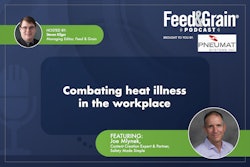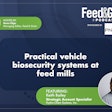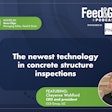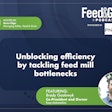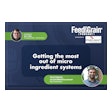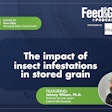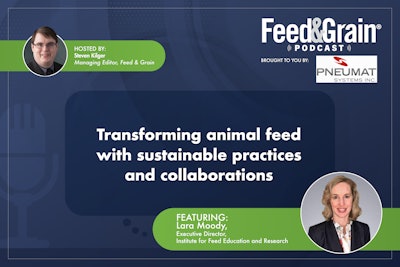
In the latest episode of the Feed & Grain Podcast, host Steven Kilger talks with Lara Moody, executive director of the Institute of Feed Education and Research (IFEEDER), about the organization's current projects and initiatives. Topics include the sustainability roadmap, ingredient consumption datasets, and the importance of communication in the feed industry. Moody highlights IFEEDER's mission to advance understanding and trust in the sustainable animal feed supply chain through research and education. Don't miss this insightful discussion on the future of animal feed and pet food industries.
Steven Kilger - 00:00
Hello, my name is Steven Kilger and I'm the managing editor of Feed & Grain Magazine and host of the Feed & Grain Podcast. Thank you so much for joining me today as we dive deep into the issues affecting the feed manufacturing, grain handling, and antler industries.
Today's episode is brought to you by the BinWhip from Pneumat Systems. The powerful dual-impact BinWhip removes the toughest buildup and blockages in industrial storage silos without hazardous silo entry. Learn more today at binwhip.com.
In today's episode, my guest, Lara Moody, Executive Director at the Institute of Feed Education and Research, is here to talk about what projects the organization is working on for the animal feed industry. From the sustainability roadmap to the ingredient consumption datasets, IFEEDER is working hard to give the industry the tools it needs to send out a positive message about itself.
I hope you enjoyed the interview. If you want to help with the podcast or listen to this in a podcasting app, please rate us and subscribe. If you're listening online, sign up for the Feed & Grain newsletter, Industry Watch, to see when all the newest podcasts drop and to stay up to date with all the latest news from around the industry. Now, onto the show. Hi, Lara, thanks so much for joining me on the podcast today.
Lara Moody - 01:13
Steve, thanks so much for inviting me back to talk about IFEEDER.
Kilger - 01:17
Yeah, you're one of our returning guests and I always really appreciate you coming on here. IFEEDER was new when I just started in the industry. I've kind of grown in the industry with IFEEDER, so I'm always really interested in your guys' mission and your goal and how you're doing, because it just, you know, correlates with my own career. So it's always really nice to hear from you guys.
Moody - 01:36
Excellent. I'm glad we can provide that kind of support for you, Steve.
Kilger - 01:41
But for anyone who might not know IFEEDER, what do you guys do, can you talk a little bit about your mission and your support for the American feed industry?
Moody - 01:50
So IFEEDER is The Institute for Feed Education and Research, it's the research and education foundation that supports the U.S. feed industry and we do work very closely with the American Feed Industry Association. Our mission is to advance understanding and trust in the sustainable animal feed and pet food supply chain through research and education and we pursue that with contributions grants and other awarded dollars from industry and stakeholders so that we can invest in the industry.
Kilger - 02:24
Yeah, and you guys are doing more than you've ever done before as someone once again who's been following Eyefeeder for pretty much its entire existence. I mean, you guys seem like you have so many projects, and your hands in so many pots right now.
Moody - 02:37
Indeed, we are really trying to provide resources that touch all aspects of the feed industry and our membership and so that means working across a broader landscape that's not only our feed industry members but a lot of the stakeholders which in most cases are either on the upstream kind of supply side of us or they're on the downstream customer side of us and by that I mean our Mostly our animal ag customers and so that just broadens the landscape where we engage and it broadens the number of stakeholders we communicate and work with and it's blended itself well to increasing the number of opportunities that we have available us.
Kilger - 03:23
Yeah, exactly, more and more today. The feed industry is not a monolith, so we work together. We're part of the animal agriculture supply chain, so it's really important that we work with all the factors of it. You had your board of trustees meeting. You welcomed in some new trustees, you thanked some for working as they left. And I just got really fascinated by the whole process.
How often do you have a board of trustees meetings? What gets discussed there? And then also what is a trustee? What do they do? How are they involved? And how do maybe someone's interested in becoming one? How do they start to get their foot in that door?
Moody - 04:02
So IFEEDER's board of trustees is a key component of the workings of IFEEDER and to be clear our trustees are selected based on a set of requirements within our bylaws but essentially our board members represent a variety of aspects of the feed industry so we have members that represent Cooperatives, feed mills, ingredient manufacturers, ingredient suppliers, equipment providers, and even the aspect of our feed industry that is our customer.
So, we currently have representation from Dairy Management, Inc. On our previous board, we had also representatives from the National Pork Board. So it's helpful to us to have this nice mix of feed industry members because our board generally, what they do is provide perspective and insights into IFEEDERs operations.
Now they also have financial responsibilities as well, but basically, We're using them as a sounding board and an opportunity for us to gather insights from the industry so that we can act to serve the industry. And so our board gets together three times a year we generally meet at the same time as the AFIA board because some of our members are in common by our bylaws.
We're required to have a certain fraction of our board members are also AFIA board members. But beyond that, we always seek to broaden our perspective and so that's why we bring on somebody like Dairy Management, Inc. or we might bring in A sustainability expert from one of our member companies who maybe doesn't serve on the board but who we'd like to have their insights.
And so our board rotates, we usually have three folks come on and three folks go off each year and that gives us the opportunity to always have the historical perspective of IFEEDER But also to have new folks coming in. And then just out of interest, AFIA's, because of our linkage to the American Feed Industry Association, AFIA's outgoing board chair is our incoming chair. So Carlos Gonzalez just got done serving for the AFIA board of directors as the current chair, so he's now our IFEEDER chair. So that's how it works.
Kilger - 06:42
Yeah, well, it's an interesting way to do it too because associations, other trusts, like they just, the whole board almost cycles every single year or two years, it seems.
It's really interesting that you're constantly getting infused with those new ideas, but you also have a semblance of stability in it, which is really important because no organization can have a new directive every single year.
Moody - 07:04
No. And that's also why we have our strategic plan that is the core of what we do, right? That helps carry us through that changing board members as well.
Kilger - 07:14
Yeah, you're doing so much. The main thing that I always think about when I think I feed it right now, though, is your sustainability roadmap, your animal food industry toolkit. How is that going? How is that moving along since we talked to you last in January, I believe? And are there other educational initiatives, too, that you're excited about?
Moody - 07:33
Yeah, so we are making progress on the current phase of our roadmap efforts, and in fact, we are going to be releasing in July a couple of new resources that have stemmed from that. So, one resource that we're very excited about coming out of that work is something that we work to develop in coordination or in collaboration with some students at Iowa State University.
So, Dr. Kurt Rosentrader's Engineering for Sustainability course helped us define and identify the importance of several material issues for the feed industry. In our previous work, we identified 16 issues that were relevant or material to the business of the American feed industry, and then in this project we wanted to better define what those issues are, identify why a feed industry member, animal food industry member, might be interested in Reporting on or setting goals in that area or identifying that as something for their organization of importance in their sustainability program.
And then we also, importantly, wanted to provide narratives or examples of feed members that were actually doing something within each of these different material issue areas. At the start of the project, most folks when I go out and talk about sustainability immediately think I'm talking about greenhouse gas emissions and they immediately think that the focus of sustainability efforts is on climate change.
And so we wanted them to understand that it's much bigger than that and that in fact it's up to any of our industry members to define which issues are important to them and it isn't necessarily greenhouse gas emissions. So this resource is going to give them Some insights into where they may start their materiality assessment, what issues they may want to utilize themselves, as well as help them understand what those issues are and what they may already be doing to support those that they just aren't talking about.
So that's one resource we have coming up. That resource will be out sometime in July. You'll be able to find it on our website at ipeter.org or if you see the newsletter, there'll be information there. We also have two more resources that are coming out and being added to the toolkit and they're a little bit in combination.
We've been working with the context network to better understand the data needs of our customers, the feed industry's customers, relative to some of those material issues. For example, Relative to water use feed safety greenhouse gas emissions or energy. And so we've mapped out what many of the allied animal organizations from the Pet Food Institute to the U.S. Roundtable for Sustainable Beef are looking to Track and report towards their goals in those different areas. And so, we've mapped that for members to see.
We've also, through survey work with again those allied organizations, surveyed them about What their challenges are in the data space around feed and what their data needs are, which will provide insights and what our members can be providing or should be thinking about as they're looking to support our allied animal organizations in that space. And then the third one that is part of that is the work that we've done to map what it would look like to use performance measures for animal production as a way to reduce the environmental impact.
So we pursue Animal nutrition to help us improve average daily gain or improve feed conversion efficiency. What do those performance metrics, like what do those improvements do to reduce the footprint of animal ag through feed and nutrition? And so that is a literature review and a data set as well as what it would look like to map those and what additional information needs, we have to be able to do that. So that resource is also coming out. So, there are three things that are forthcoming. We anticipate all those to be available in July so that work continues to create resources to support the industry.
Kilger - 12:43
I truly believe it's about teaching animal agriculture and especially our industry about just telling our story. So much of it has been silent for so long. I was actually discussing with some friends the other day about agriculture's impact on climate. And yeah, while everything's not perfect, I've also never seen an industry. So, so many people are trying, always trying new things. We're always trying to make things better. And to be able to share that with people, I think is really, really important. So that they know that they're not committing some grave sin by buying beef at the grocery store every week.
Moody - 13:18
Well, communication is a big element of it and feed doesn't always do enough to tell our part of the story. And part of that's just because we don't quite know how to do that or we don't know what we should be conveying to do that. Or maybe we just aren't supporting our Customers are animal-ag folks enough in that space and there's more we can do there. And so that's putting resources together that can better enable our members to do that is one of the things that we're trying to Yeah, and you're doing a very good job of it as well.
Kilger - 13:56
I completely get it too. I get where people are coming from I also just want to, you know, sit back and do my job. I have to advocate for myself all the time, but it's something you have to do in this modern world of ours. One of the projects I saw included during your last board meeting was your updating datasets for the US feed and pet food ingredient consumption. Can you talk a little bit more about those and how useful and what they mean to the industry?
Moody - 14:19
Yeah. Well, this gets a little bit to be able to communicate better, especially to be able to communicate the scope and value of the animal feed and pet food industry.
Prior to my coming to IFEEDER in 2018-2019, IFEEDER partnered with the Pet Food Institute and the North American Renders Association to develop the first pet food report that was a comprehensive kind of analysis of All of the different ingredients that go into pet food and what the, not only what the scope of those ingredients are and quantifying how much of them are used and where they're used from a geographic standpoint, but also where they're coming from and the value of those ingredients throughout the supply chain.
So the value that they bring to our rural and urban communities. So really just A dataset that allows us to understand the extensive scope of ingredients in the pet food space and the value that they bring, that the industry brings, right, in supporting the population's pets, dogs, and cats primarily.
And, you know, that dataset I have been contacted countless numbers of times by university students, by federal agencies, by industry members themselves, looking for that data or more details about that data. We've had, just most recently, a Penn State University student seeking that data that they were going to use as part of their assessment for the amount of Pennsylvania-grown crops that were going into pet food.
And so we never quite know where the requests for the data are going to come from, but the data set is used often, I would say. So we're going to be number one in updating that report. So we feel like that's a report that we should update on a semi-continual basis. The other report is the ingredient consumption report and that's much larger than pet food. So that's looking at, I would say, domestic animals.
We basically are looking at 10 different species, including equine and aquaculture. And we look at a collective of 47 different ingredients that were included in the last report. So again, this very diverse Use of ingredients in the feed space. The first report was done in 2017. It was updated with 2020 data and released in 2021. So again, it's timely to be able to update and release that report again. Basically, for both of these reports, you know, we know that animal production itself changes, right? The number of animals that are being produced or the number of animals that are out there, the nutrition for them is always evolving. Pet consumer purchasing decisions, just the number of additional pets, you know, think about the last pet food report that came out prior to COVID.
We know that one of the trends was people purchasing pets during COVID and so we expect to see changes, right, in those pet food consumption numbers. And then we also have the availability of ingredients for ever-changing. And so all of those things lead us to realize that we need to update both of those reports. So that effort is getting underway. Actually, we just All agreed on the contract yesterday and the ingredient consumption report is supported by the North American Renders Association and the American Feed Industry Association, those are our plan partners. We are of course looking for other collaborators or investors in those projects because We are not a member-based organization, we do have to raise funds for these projects and so we are in the process of fundraising for both of those so if there are folks that are interested in the outcomes of those reports or would like to be part of the advisory committee or get a sneak peek into the data before it's available, we have an investor group that we will do that with and so it would be great.
If folks were interested in supporting us in those efforts.
Kilger - 19:24
It's our industry. People need to get involved to communicate. Wow, before COVID, right? A completely different world.
Moody - 19:33
Yes, yeah, especially in the pet space. And so, at this time, you know, interestingly, we had to, one of the things that We agreed, our board back in May agreed to sort of port these projects and you're like, well, why isn't this project underway yet? And so fascinatingly, we were looking for the pet food project. We actually buy data from Nielsen so that we understand the point of sale. We can't obviously do that for the broader animal ingredient report because there's no Nielsen data for what comes from a feed mill, but for pets, we can buy actual data of purchasing decisions and so previously we've just used point of sale or brick-and-mortar store data. But now this year we had to look at using also obtain some online data, right? Because I myself buy my cat's cat food online and so many other folks are doing that now as well.
And so we felt like we needed to relook at how we were going to be pulling the data. So anyway, those are things that are changing that we need to be aware of and it's just again another reason why we need to update the reports.
Kilger - 20:43
Yeah, I just kind of assume my delivery person hates me at this point when I get cat litter delivered and cat food delivered. Well, we've been speaking about it this whole time, but really the message I'm seeing is like communication, right? It's so important. I noticed that IFEEDER has really upped its own communication game. Can you tell us a little bit more about your blog and your newsletter that's coming out once a month it's always been really amazing. I love your little updates there at the top.
Moody - 21:11
Well, we are continuing to put our newsletter out on a monthly basis. We're in the process of updating that, so it's going to have a fresh look the next time you see it.
Hopefully a little easier to find and see some content. We recently added the blog, so when we updated our website, when we refreshed our web page, one of the elements we wanted to add was a blog. Just so we could have another way of providing more content, right? Content is king these days as we're thinking about how we're using it on social media. So things like this podcast that I'm doing with you or the blog or the newsletter, all of those things give us content that we can use on our LinkedIn page, which is a growing source for us.
But really the push behind IFEEDER's communication strategy Is getting our name, getting our brand out there. So, we have, you know, when we surveyed industry members two years ago, I guess, now what we realized is that there were many industry members that really didn't know the difference between AFIA and IFEEDER. And that's a challenge for us, especially from a fundraising standpoint. We also realized that folks who knew IFEEDER couldn't necessarily say what our mission was, except for that it was for education and research. And so we have been working diligently to get IFEEDER's brand out there. And get some name recognition as well as be able to better communicate all of the good work that we are doing.
And so we work really closely with the AFIA's communications team and I think the work that we've done in the last three years is really starting to show you're noticing it, other folks are noticing it, And it's a really valuable piece of the work that IFEEDER does and it's really important because why do all this great work for the industry if nobody knows about Yeah, exactly.
Kilger - 23:14
We will have links to the newsletter page and the IFEEDER website, but for anyone who's only listening, do you want to tell people where they can find out more information about IFEEDER?
Moody - 23:28
Yes, super easy. You can go to IFEEDER.org. You can, on that site, sign up for the newsletter if you would like to receive it on a monthly basis. You can check out the blog, and you can learn about the variety of research and education projects we have underway. Links to all the resources that we develop are available there, so I would encourage folks to go visit IFEEDER.org.
Kilger - 23:57
And I would encourage folks to sign up for the newsletter because it really is quite good. I've been enjoying getting it in my inbox every month. Well, thank you so much for joining me today, Lara. I really appreciate having you on.
Moody - 24:09
Steve, thanks again for inviting IFEEDER back to your podcast.
Kilger - 24:16
We'll have to have you on pretty soon because until then, thank you for coming. Everyone out there listening, thank you so much for doing that, and until next time, stay safe.
.jpg?auto=format%2Ccompress&crop=faces&fit=crop&h=48&q=70&w=48)


